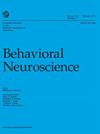间接和直接大麻素激动剂对间叶多巴胺释放和相关行为的影响各不相同。
IF 1.5
4区 医学
Q3 BEHAVIORAL SCIENCES
引用次数: 0
摘要
大麻素系统正被作为治疗多种疾病的潜在药物靶点进行研究。本研究考察了间接和直接大麻素激动剂对 C57BL/6J (B6) 小鼠间叶多巴胺释放和相关行为的影响。间接大麻素激动剂 N-arachidonoyl 血清素(AA-5-HT)通过抑制脂肪酸酰胺水解酶阻止内源性大麻素的代谢,同时抑制瞬时受体电位香草素 1 型通道,从而间接激动大麻素系统。我们将 AA-5-HT 的作用与直接大麻素受体 1 型激动剂花生四烯丙基-2'-氯乙基酰胺(ACEA)进行了比较。在实验 1 中,每天给小鼠注射七次 AA-5-HT、ACEA 或车辆进行预处理,然后使用开阔地(OF)测试评估运动活动,并使用体内固定电位安培计评估多巴胺的阶段性释放。长期暴露于AA-5-HT不会改变运动活动或多巴胺间叶功能。长期暴露于乙酰乙酰乙酰胆碱酯酶会降低小鼠的饲养能力并减少阶段性多巴胺释放,同时增加小鼠对可卡因的多巴胺能反应。在实验2中,小鼠接受了AA-5-HT、ACEA或载体的条件性位置偏好测试,然后又接受了糖精偏好测试,这是一种通常与失乐症相关的测量方法。小鼠对AA-5-HT或ACEA没有产生条件性位置偏好或厌恶,重复暴露于AA-5-HT或ACEA也没有改变对糖精的偏好。总之,研究结果表明,这两种药物都不会诱导小鼠产生与滥用相关的行为;不过,与间接大麻素激动作用相比,直接大麻素受体 1 型激动作用可能在介导间叶多巴胺功能方面发挥更大的作用。(PsycInfo Database Record (c) 2024 APA,保留所有权利)。本文章由计算机程序翻译,如有差异,请以英文原文为准。
Indirect and direct cannabinoid agonists differentially affect mesolimbic dopamine release and related behaviors.
The cannabinoid system is being researched as a potential pharmaceutical target for a multitude of disorders. The present study examined the effect of indirect and direct cannabinoid agonists on mesolimbic dopamine release and related behaviors in C57BL/6J (B6) mice. The indirect cannabinoid agonist N-arachidonoyl serotonin (AA-5-HT) indirectly agonizes the cannabinoid system by preventing the metabolism of endocannabinoids through fatty acid amide hydrolase inhibition while also inhibiting transient receptor potential vanilloid Type 1 channels. Effects of AA-5-HT were compared with the direct cannabinoid receptor Type 1 agonist arachidonoyl-2'-chloroethylamide (ACEA). In Experiment 1, mice were pretreated with seven daily injections of AA-5-HT, ACEA, or vehicle prior to assessments of locomotor activity using open field (OF) testing and phasic dopamine release using in vivo fixed potential amperometry. Chronic exposure to AA-5-HT did not alter locomotor activity or mesolimbic dopamine functioning. Chronic exposure to ACEA decreased rearing and decreased phasic dopamine release while increasing the dopaminergic response to cocaine. In Experiment 2, mice underwent AA-5-HT, ACEA, or vehicle conditioned place preference, then saccharin preference testing, a measure commonly associated with anhedonia. Mice did not develop a conditioned place preference or aversion for AA-5-HT or ACEA, and repeated exposure to AA-5-HT or ACEA did not alter saccharin preference. Altogether, the findings suggest that neither of these drugs induce behaviors that are classically associated with abuse liability in mice; however, direct cannabinoid receptor Type 1 agonism may play more of a role in mediating mesolimbic dopamine functioning than indirect cannabinoid agonism. (PsycInfo Database Record (c) 2024 APA, all rights reserved).
求助全文
通过发布文献求助,成功后即可免费获取论文全文。
去求助
来源期刊

Behavioral neuroscience
医学-行为科学
CiteScore
3.40
自引率
0.00%
发文量
51
审稿时长
6-12 weeks
期刊介绍:
Behavioral Neuroscience publishes original research articles as well as reviews in the broad field of the neural bases of behavior.
 求助内容:
求助内容: 应助结果提醒方式:
应助结果提醒方式:


